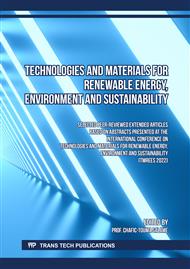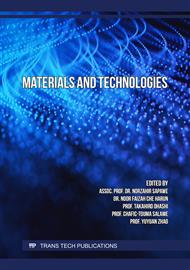[1]
Addington, D. M., & Schodek, D. L. (2012). Smart materials and technologies in architecture. Smart Materials and Technologies in Architecture, 1–241. https://doi.org/10.4324/9780080480954.
DOI: 10.4324/9780080480954
Google Scholar
[2]
Brostowitz, N. R., Weiss, R. A., & Cavicchi, K. A. (2014). Facile fabrication of a shape memory polymer by swelling cross-linked natural rubber with stearic acid. ACS Macro Letters, 3(4), 374–377. https://doi.org/10.1021/mz500131r.
DOI: 10.1021/mz500131r
Google Scholar
[3]
Capiel, G., Marcovich, N. E., & Mosiewicki, M. A. (2019). Shape memory polymer networks based on methacrylated fatty acids. European Polymer Journal, 116, 321–329. https://doi.org/10.1016/j.eurpolymj.2019.04.023.
DOI: 10.1016/j.eurpolymj.2019.04.023
Google Scholar
[4]
Chen, W. C., Lai, S. M., Chang, M. Y., & Liao, Z. C. (2014). Preparation and properties of natural rubber (NR)/polycaprolactone (PCL) bio-based shape memory polymer blends. Journal of Macromolecular Science, Part B: Physics, 53(4), 645–661. https://doi.org/10.1080/00222348.2013.860304.
DOI: 10.1080/00222348.2013.860304
Google Scholar
[5]
Dolog, R., & Weiss, R. A. (2017). Properties and shape-memory behavior of compounds of a poly(ethylene-co-methacrylic acid) ionomer and zinc stearate. Polymer, 128, 128–134. https://doi.org/10.1016/j.polymer.2017.09.010.
DOI: 10.1016/j.polymer.2017.09.010
Google Scholar
[6]
Dong, Y., Xia, H., Zhu, Y., Ni, Q. Q., & Fu, Y. (2015). Effect of epoxy-graft-polyoxyethylene octyl phenyl ether on preparation, mechanical properties and triple-shape memory effect of carbon nanotube/water-borne epoxy nanocomposites. Composites Science and Technology, 120, 17–25. https://doi.org/10.1016/j.compscitech.2015.09.011.
DOI: 10.1016/j.compscitech.2015.09.011
Google Scholar
[7]
Heuwers, B., Quitmann, D., Katzenberg, F., & Tiller, J. C. (2012). Stress-induced melting of crystals in natural rubber: A new way to tailor the transition temperature of shape memory polymers. Macromolecular Rapid Communications, 33(18), 1517–1522. https://doi.org/10.1002/marc.201200313.
DOI: 10.1002/marc.201200313
Google Scholar
[8]
Higham, T. E., Measey, G. J., Birn-Jeffery, A. V., Herrel, A., & Tolley, K. A. (2015). Functional divergence between morphs of a dwarf chameleon: Differential locomotor kinematics in relation to habitat structure. Biological Journal of the Linnean Society, 116(1), 27–40. https://doi.org/10.1111/bij.12566.
DOI: 10.1111/bij.12566
Google Scholar
[9]
Hoeher, R., Raidt, T., Rose, M., Katzenberg, F., & Tiller, J. C. (2013). Recoverable strain storage capacity of shape memory polyethylene. Journal of Polymer Science, Part B: Polymer Physics, 51(13), 1033–1040. https://doi.org/10.1002/polb.23301.
DOI: 10.1002/polb.23301
Google Scholar
[10]
Kow, Y. Y., Chai, A. B., & Ho, J. H. (2020). Relationships between swelling temperature and shape memory properties of palmitic acid-based shape memory natural rubber. Journal of Rubber Research, 23(1), 13–22. https://doi.org/10.1007/s42464-019-00031-w.
DOI: 10.1007/s42464-019-00031-w
Google Scholar
[11]
Li, G. (2014). Self-Healing Composites: Shape Memory Polymer Based Structures. Self-Healing Composites: Shape Memory Polymer Based Structures, 9781118452, 1–370. https://doi.org/10.1002/9781118452462.
DOI: 10.1002/9781118452462.ch04
Google Scholar
[12]
Melly, S. K., Liu, L., Liu, Y., & Leng, J. (2020). Active composites based on shape memory polymers: overview, fabrication methods, applications, and future prospects. Journal of Materials Science, 55(25), 10975–11051. https://doi.org/10.1007/s10853-020-04761-w.
DOI: 10.1007/s10853-020-04761-w
Google Scholar
[13]
Meng, Q., & Hu, J. (2009). A review of shape memory polymer composites and blends. Composites Part A: Applied Science and Manufacturing, 40(11), 1661–1672. https://doi.org/10.1016/j.compositesa.2009.08.011.
DOI: 10.1016/j.compositesa.2009.08.011
Google Scholar
[14]
Pantoja, M., Lin, Z., Cakmak, M., & Cavicchi, K. A. (2018). Structure–property relationships of fatty acid swollen, crosslinked natural rubber shape memory polymers. Journal of Polymer Science, Part B: Polymer Physics, 56(8), 673–688. https://doi.org/10.1002/polb.24578.
DOI: 10.1002/polb.24578
Google Scholar
[15]
Safranski, D., & Griffis, J. C. (2017). Shape-Memory Polymer Device Design. Shape-Memory Polymer Device Design, 113–137. http://dx.doi.org/10.1016/B978-0-323-37797-3.00004-X.
DOI: 10.1016/b978-0-323-37797-3.00006-3
Google Scholar
[16]
Wadhawan, V. K. (2007). Smart Structures: Blurring the Distinction Between the Living and the Nonliving. Smart Structures: Blurring the Distinction Between the Living and the Nonliving,9780199229,1–368. https://doi.org/10.1093/acprof:oso/9780199229178.001.0001.
Google Scholar
[17]
Wee, J. S. H., Chai, A. B., & Ho, J. H. (2017). Fabrication of shape memory natural rubber using palmitic acid. Journal of King Saud University - Science, 29(4), 494–501. https://doi.org/10.1016/j.jksus.2017.09.003.
DOI: 10.1016/j.jksus.2017.09.003
Google Scholar
[18]
Wu, X. L., Huang, W. M., Lu, H. B., Wang, C. C., & Cui, H. P. (2017). Characterization of polymeric shape memory materials. Journal of Polymer Engineering, 37(1), 1–20. https://doi.org/10.1515/polyeng-2015-0370.
Google Scholar
[19]
Xia, L., Chen, S., Fu, W., & Qiu, G. (2019). Shape memory behavior of natural Eucommia ulmoides gum and low-density polyethylene blends with two response temperatures. Polymers, 11(4). https://doi.org/10.3390/polym11040580.
DOI: 10.3390/polym11040580
Google Scholar
[20]
Xia, L., Xian, J., Geng, J., Wang, Y., Shi, F., Zhou, Z., Lu, N., Du, A., & Xin, Z. (2017). Multiple shape memory effects of trans-1,4-polyisoprene and low-density polyethylene blends. Polymer International, 66(10), 1382–1388. https://doi.org/10.1002/pi.5387.
DOI: 10.1002/pi.5387
Google Scholar
[21]
Xie, F., Huang, C., Wang, F., Huang, L., Weiss, R. A., Leng, J., & Liu, Y. (2016). Carboxyl-Terminated Polybutadiene-Poly(styrene-co-4-vinylpyridine) Supramolecular Thermoplastic Elastomers and Their Shape Memory Behavior. Macromolecules, 49(19), 7322–7330. https://doi.org/10.1021/acs.macromol.6b01785.
DOI: 10.1021/acs.macromol.6b01785
Google Scholar
[22]
Yahia, L. (2015). Shape Memory Polymers for Biomedical Applications. In Shape Memory Polymers for Biomedical Applications. https://doi.org/10.1016/C2013-0-16350-7.
DOI: 10.1016/b978-0-85709-698-2.00001-5
Google Scholar
[23]
Zhang, Q., & Feng, J. (2013). Difunctional olefin block copolymer/paraffin form-stable phase change materials with simultaneous shape memory property. Solar Energy Materials and Solar Cells, 117, 259–266. https://doi.org/10.1016/j.solmat.2013.06.020.
DOI: 10.1016/j.solmat.2013.06.020
Google Scholar



